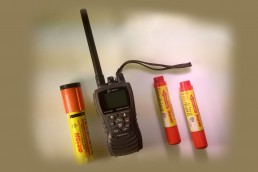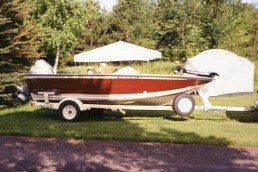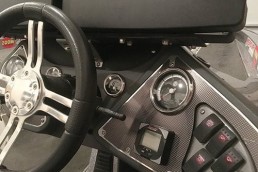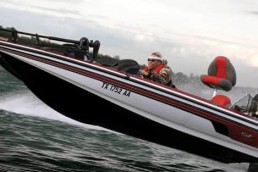SHARE THIS POST
No one likes to be preached at about safety, but read because I’m going to tell you about the time I hung on to a cooler for almost four hours after our boat sank five miles out on Lake Michigan. Complacency regarding boating safety can kill you; it was this that almost killed the four of us. Prepare for bad things happening, because they might.
In July 2012, I was a guest of Matt Serbenski’s on his 18-foot, center-console Lake Assault boat. Also along was Matt’s 50-year-old cousin John Bruner who was up visiting from southern Indiana, and Matt’s son Jack. We met before daylight in Paw Paw, and trailered the 30 miles to launch on at South Haven with our friend Al Malsch, also there, who had his 17-foot aluminum Sea Nymph with a crew of Travis and Tyler Malsch and his 7-year-old grandson.
It was a little windy at the ramp and was wavy as we headed out onto the lake, but not intimidating. Other than John, the only one who’d been on his second big-water trip, we’d all been out in worse conditions. John actually got a little seasick, but fishing was decent and we put three king salmon into the by 10 a.m.
We started thinking about going in around 10:30, as we heard a distant clap of thunder. Then, we had a massive tangle involving copper lines out on planer boards and a wire Dipsy—the worst sort of tangle you can have in salmon fishing. Worse yet, the tangle got caught in the lower unit of the outboard while I was working on detangling.
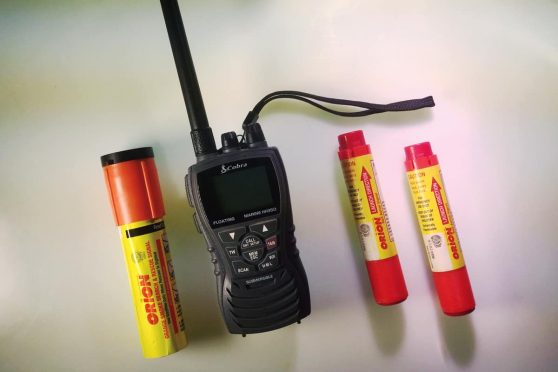
So, we immediately shut the 90-hp Honda off with the boat pointed downwind. Now, the waves were slapping the transom. Matt, a former collegiate defensive lineman weighing 300 pounds, and I, around 245, worked on the tangle at the stern and put a lot of weight back there. To make a long story short, we took about three good waves over the back. It wasn’t before long we had the presence of mind to realize what was happening: after three waves, tackle boxes were washing around the floor of the boat.
One more wave came over and the boat flipped. I had just enough time to grab an inflatable life jacket I’d brought along. Young Jack was the only one wearing a life jacket, which his mother Jana had requested. John had the Coleman cooler we’d brought to keep drinks cold in and Matt had a seat-cushion-style throwable PFD. Out boat just turtled at first, and then it sank out of sight.
But we had all survived.
Right after the boat sank, I traded my inflatable vest for the cooler with John, who was now having a tough time keeping his head above water with it. After I figured out that if I held the cooler upside down—drinks and ice rumbling around inside—the pressure of the water would keep it closed. It worked best when I held the handles with my fingers splayed outward, which then made it easier to keep the cooler in front of me. Otherwise, holding the cooler handles with my thumbs toward me, my legs tended to slip forward with the cooler coming up toward my face and water would into my nose and mouth.
I wrote about this event the day after it happened, and it’s in a long blog post. You can also read about some other slightly humorous, but very dumb, stuff like me having to read the directions on expired flares to figure out how to fire one while a boat cruised by in plain sight, about 300 yards away. But for safety purposes, let’s talk about what we did wrong aside from being in a fairly new boat that wasn’t designed necessarily to stay afloat in choppy conditions.
The mistakes we made include:
Are you enjoying this post?
You can be among the first to get the latest info on where to go, what to use and how to use it!
1. We all should’ve been wearing PFDs, instead of only Jack wearing one. At the very least, the PFDs should have been out on the backs of chairs or someplace where we could’ve grabbed them easily, or after the sinking, where they might’ve floated up when the boat sank.
2. We should’ve had an in-dash radio and someone should’ve been wearing a waterproof, handheld marine radio on his belt to use to call for help. No one other than us knew of our plight until almost four hours later, when Al happened to spot the cooler while still trying to fill out his limit of salmon. I got rescued first, followed by John, who then was found by a boat we had flagged down. The Coast Guard chopper dispatched to the scene, arrived 45 minutes after Al had found me, and almost immediately spotted Matt and Jack.
3. The whole incident would’ve never happened if we had had a sea anchor to tie off a forward cleat so the boat would face the waves and ride up and over them. Instead, with the bow pointed downwind, the waves little by little added access water to the boat until it took about four more to completely swamp us.
4. We should’ve had a ditch kit, basically a waterproof, floating case, which included flares (both aerial and a handheld smoke flares), a waterproof headlamp with a strobe (if we’d have capsized at night) and some sort of noisemaker like a loud whistle or a handheld air horn. The whistle should be on a lanyard to wear around you neck, and is probably a better option since you can easily drop an air horn or it could develop a leak and be useless by the time you need it. A small mirror with rounded edges would’ve helped us reflect light from the sun toward shore. A floating handheld marine radio is another good item to have in the ditch kit, even if it’s a second radio to the one worn by someone aboard wearing it in a belt. I have paid $100 for a floating radio made by Cobra.
5. We all should’ve had our phones in waterproof cases. Mine was unprotected in my pocket and immediately useless. We should’ve preprogrammed the number for the Coast Guard in our phones.
We had survived this accident pretty much out of dumb luck. Luckily, we had a cooler that floated, Matt had a seat cushion and we had one inflatable PFD that worked. We were also extremely fortunate that the water temperature was 70 degrees, which we learned later was actually a record high for southern Lake Michigan in July. Had it been just 10 degrees cooler we would’ve been at serious risk of hypothermia after being in the water for almost four hours and longer. If we’d capsized in April or May, with water temperatures in the 50s or colder, it’s probable that none of us would have survived.
When our ordeal was over, and after a tearful reunion back at the launch ramp where Matt and Al had parked that morning, the four of us castaways rode home together in Matt’s truck. We actually had a good laugh in that Jack had told Matt as they swam toward shore how much he had regretted losing the fish that went down with the boat.
One thing really stands out in my mind, and is from a remark John Bruner, an avid scuba diver, had made.
“You know, when you’re training to get your scuba certification, they really drill into you that complacency kills,” John relayed. “It’s when you get overconfident that nothing will happen to you and don’t prepare for bad things to happen that you can really get into trouble.”
Please don’t be complacent about boating safety.
MWO
SHARE THIS POST
Did you enjoy this post?
You can be among the first to get the latest info on where to go, what to use and how to use it!
Dave Mull
Dave Mull of Paw Paw, Mich. has spent his career communicating the outdoors experience and runs Inner Viking Media. He enjoys kayak fishing for anything that swims in the lakes and rivers of the Midwest and beyond, and even uses his MirroCraft, from time to time. Available for seminars.
